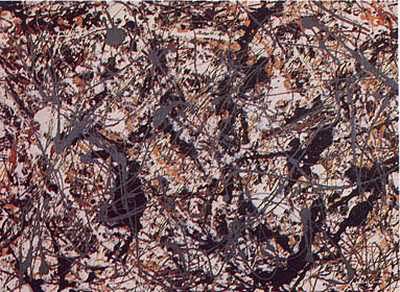Math has influenced art in many ways; from books like Edwin
Abbott’s Flatland to the pyramids of
Egypt mathematical principles cannot be escaped (Abbott). Works of art make use
of perspective and the golden ratio to construct an ideal image. The golden
ratio, 1.618, can be used to define proportions of the human body as seen in
the Vitruvian man or the Greek’s Parthenon (Vitruvian Man).
Fractals are a pattern that repeats itself at different
scales, perhaps most famously seen in nature in snowflakes. They have been used
for hundreds of years in tribal African textiles, sculptures, and even
hairstyles. In Western art, Pollack makes use of them in his seemingly splatter
paint creations. In 1949, many critics lamented at a reporter calling Pollack “one
of the greatest living painters in the US”. However, they did not understand the
complexity behind his refined drip technique in which layers upon layers of
paint in order to create precise fractals between D=0 and D=3. The fractal
characteristic of the artist has even been used to determine counterfeits of
his work (Oullette).
The juxtaposition of math and art has become more and more
intertwined as time as gone on. The rise in prominence of computers creates the
opportunity for the two converge on the same path. Computer technology has
already been used to increase the production on animation films and will
continue to invade and push the creativity of artists.



I find your analysis of how math and art are used to make films along with the aid of computers very relevant. Animation films are very popular, and with the help of math and computers to carry out the many calculations, can be made to look more pleasing. This is similar to how the golden ratio makes art look better to human perception. In addition, the movies can be made faster with mathematics and computers.
ReplyDeleteHamilton Trinh
I think it's really interesting that you mention animation as an example of how math plays an integral part in the creation of art. I remember I used to watch all the behind the scenes "Making Of" the movies where they would show the artists working hard drawing hundreds and thousands of pictures. They don't, however, always show how many calculations and math goes into actually making these characters and scenes come alive (probably because they wouldn't be very interesting to children). Sometimes, to create art, we need to put in just as much numbers and formulas as creativity.
ReplyDeleteI am glad you brought up animation as one of the ways math and art have come together to create something. It is a fascinating that a computer can make something so life like. When I was at California Adventure I went to the animation studio and took a class on how to draw Olaf. We only drew circles, ovals, and cylinders the entire time. Olaf's entire body is just made out of geometric shapes. I also enjoyed how you went through the history of math and art. It is amazing how far we have come, from the Vitruvian man to animation on computers.
ReplyDelete